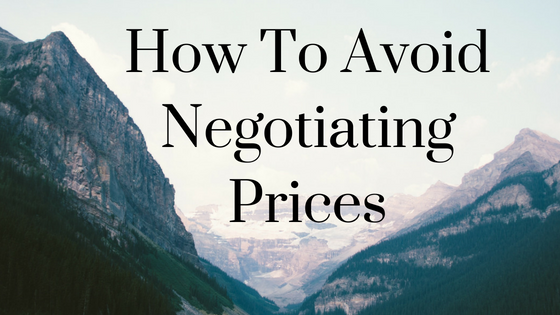Bargaining is an age-old practice, and it's common for customers to try to negotiate for better prices when booking tours and activities.If you see bargaining as an unavoidable part of doing business, you end up rationalizing that it's okay. Even though "everyone" seems to be doing it, that doesn't make it a best practice in almost any kind business—including tour operations. In reality, you probably shouldn't let them negotiate at all, unless you've already set your prices higher than they should be.One problem with accepting customers' requests for a lower price is that it can destroy trust and cheapen your brand—as well as people's perceptions of the value you provide. If a customer who walks in today can get a discount that is different than another customer who purchases the exact same thing from you tomorrow, you should hope they never compare notes. This can be especially damaging to tour operators, where word-of-mouth and referrals are a major source of new customers.Negotiating also erodes prices at the same time it optically lifts them. If lowering your prices is what it takes to win a customer, your competitor will also do it. Then it turns into a race to the bottom of who can offer the cheapest experience and still make a profit. The margins become so tight that each operator has to pump an enormous amount of volume through their facility to make money.
If lowering your prices is what it takes to win a customer, your competitor will also do it
Giving a customer a better price occasionally may seem like no big deal, but it can add up substantially and quickly—and companies can go out of business. You shouldn't have to discount. But what can you do instead?
Say No, Then Add a Sweetener
Although this differs by culture, as a general rule people rarely ask for a better price more than two or three times. If saying no doesn't do the trick, remember that when people ask for a discount, what they may really be asking for is to make them feel special—not necessarily a concession on price.One of the easiest things you can do is to add something extra to the experience. This can increase the perceived value on their side and helps substantiate your price. Ideally, this something extra can be provided at low or no monetary cost to you.For example:
- If you're a boat excursion company offering pre-packaged trips, you can offer snacks, appetizers, and beverages for the group.
- If you offer an activity that takes five hours, extend the adventure by another 30 minutes.
- If you offer a tour, find ways to customize the experience for them.
Try Asking for Something in Return
Discounting to land new customers where you get something in return of equal—and preferably larger—value is a much better strategy. In this case, discounting isn't discounting; it's is simply exchanging things of like value to come to terms of a deal. If adding something to the experience doesn't work, you can try asking for something in exchange for a discount.If a bigger company or group is pressuring you on the price, you can:
- Ask to be the preferred tour operator in exchange for a discount. This means that all activity business would go to you first, and only to someone else when you can't meet their needs.
- Ask for a larger commitment in the form of multiple events (or more participants in the event) in exchange for the discount.
Or if you're looking to land a single new customer, you can:
- Ask the customer to commit to more than one activity in exchange for the discount.
- Ask the customer to purchase add-ons in the form of equipment upgrades or other offers.
If a monetary discount appears to be the only option to keep your customer, you'll have to weigh the pros and cons. Be sure to have standard discounts in your back pocket so you can avoid making them up on the spot. And always ask for something in return for the monetary discount.Things you can ask for include:
- a referral to another company they know and work with.
- a press release mentioning your company's name.
- a review on a popular site where your potential customers visit.
- a blog article talking about the event with a link to your site.
- a testimonial you can use on your website.
- the ability to use the company's photographs in your marketing efforts.
Also, remember that it's ok to say no. Sometimes you have to cover your costs, and sometimes saying no even has the surprising result of turning a few customers around to pay your asking price. Don't forget to have some standard discounts already prepared so you can treat customers fairly—while also protecting your margins.You really should not discount at all. If you fall into the trap that you're one of many companies that offer the exact same thing, you risk rationalizing that discounting is the cost of doing business. If you have to discount, you might as well ask for things that can help you keep your new customer for a long time—but lowering your price should be the very last thing you offer.











